analysis and determination of the stress intensity factor of load-carrying cruciform fillet welded joints
Bạn đang xem bản rút gọn của tài liệu. Xem và tải ngay bản đầy đủ của tài liệu tại đây (1.02 MB, 7 trang )
Journal of American Science 2014;10(1)
30
Analysis and Determination of the Stress Intensity Factor of Load-Carrying Cruciform Fillet Welded Joints
Nabil Mahmoud, Ahmed Badr, Fikry Salim and Amro Elhossainy
Structure Engineering Department, Faculty of Engineering, Mansourah University, Egypt.
Abstract:
Fracture mechanics is the field of mechanics concerned with the study of the formation of cracks in
materials. The determination of stress intensity factor (SIF) plays an important role in fracture analysis. This stress
intensity factor (SIF) can be determined by experimental, numerical or analytical methods. However, with
complicated component and crack geometry or under complex loading only numerical procedures are applicable. In
this study, SIF of load-carrying cruciform welded joints has been evaluated using finite element method (FEM).
Load-carrying cruciform welded joints with isosceles triangles and non-isosceles triangle fillet weld shapes were
considered and have been analyzed by the (FEM) based simulator FRANC2D/L [1] program. Moreover, the effects
of the crack position (toe, root or cold lab crack) have been considered. The objective of this paper is to study
analytically the effects of variation of crack position as well as the effect of mesh fineness and crack increment on
the stress intensity factor (K
I
) under a constant load for load-carrying cruciform fillet welded joints.
[Nabil Mahmoud, Ahmed Badr, Fikry Salim and Amro Elhossainy. Analysis and Determination of the Stress
Intensity Factor of Load-Carrying Cruciform Fillet Welded Joints. J Am Sci 2014;10(1):30-36]. (ISSN: 1545-
1003). . 7
Keywords: Fracture mechanics, stress intensity factor, cruciform joint and fillet weld
1. Introduction
The most important requirement for ensuring
the structural reliability is the prevention of brittle
fractures that can cause failure. To prevent the brittle
fracture in structures, it is very important to perform
correct welding works under consistent process
controls, and to avoid weld defects that can become
the source of brittle fractures. Particular attention
needs to be paid to the quality of the welded joints of
the strength construction, which is subject to
considerable stresses [2].
A major achievement in the theoretical
foundation of LEFM was the introduction of the
stress intensity factor K (the demand) as a parameter
for the intensity of stresses close to the crack tip and
related to the energy release rate [3]. Stress intensity
factor tightly knit with fracture mechanics which
assumes that cracks already exist in welded joints.
This factor define the stress field close to the crack
tip of a crack and provide fundamental information
on how the crack is going to propagate. In linear
elastic fracture problem, the prediction of the crack
growth and the crack direction are determined by the
stress intensity factor [4]. The stress intensity factor
(SIF) for flat crack propagation (usually referred to as
opening mode), having units of . This
single parameter K
I
is related to both: the stress level,
σ, and the flaw size, a. The fracture toughness for a
particular material (K
Ic
or K
c
) is constant value.
When the particular combination value of σ and a
leads to a critical value of K
I
; unstable crack growth
occurs and crack extension happened [5].
With fillet welded joints, stress concentrations
occur at the weld toe and at the weld root, which
make these regions the points from which cracks may
initiate [[6, 7]. Therefore Shen and Clayton [8] stated
that all the cracks were found to be initiated at the
weld end toe, the maximum stress concentration site.
In this work Load-carrying cruciform welded joints
with isosceles triangles and non-isosceles triangle
fillet weld shapes were considered and have been
analyzed by the finite element method based
simulator FRANC2D/L program. The stress intensity
factors during the crack propagation phase were
calculated by using the software FRANC2D/L, which
is shown to be highly accurate, with the direction of
crack propagation being predicted by using the
maximum normal stress criterion.
2. Material Properties.
The material used in the present study for base
material and weld metal was high strength hot rolled
steel with the yield strength Fy was taken equal to
355 MPa and fracture toughness K
IC
was taken equal
to 2000 [9]. Values of Poisson’s ratio
(υ) and the modulus of elasticity (E) were taken equal
to 0.3 and 206000 MPa respectively. The material has
been assumed to be isotropic, linear elastic.
3. Mesh Description and Boundary Conditions.
The boundary conditions of load-carrying
cruciform fillet welded joints model are shown in
Figure (1). Boundary conditions were shown as the
hinged in x-direction and y-direction for the bottom
side of the lower attached plate that was used in this
Journal of American Science 2014;10(1)
31
study. Uniform distributed stresses (F
app
) were applied at the upper edge of the upper attached plate.
X
Y
T
W
2a
B
F
app
v
u
W eld Toe Crack
W eld Root Crack
Cold Lab C rack
2a
Weld Toe Crack
Weld Root Crack
Cold Lab Crack
Main Plate
Attached Plate
Figure (1): Model Description and Boundary Conditions of Load-Carrying Cruciform Welded Joint.
4. Effect of Mesh Size on SIF, K
I
.
To investigate the convergence in results, finite
element method analyses were performed on models
with different mesh sizes as shown in Figure (2). An
existing crack has to be assumed in welded toe joint
and grows to its final length under the applied load.
Figure (3) shows the results of mesh sizes density. It
was noticed that there are no effects on the stability
of results and the very close agreements between the
three types of mesh sizes indicate that these effects
on the SIF are negligible.
(a) Fine Mesh Size
(b) Medium Mesh Size
(c) Coarse Mesh Size
Figure (2): Different Mesh Size Description of Cruciform Welded Joint.
5. Effect of Crack Increment Steps on SIF.
In order to study the simulation of crack growth,
an initial non-cohesive edge crack was placed on
fillet weld toe, perpendicular to the direction of the
applied stress, where it was predicted that critical
tensile stresses would occur. Having specified the
location of the crack, the program was able to predict
the direction in which the crack would propagate.
Prior to performing the analysis, it was necessary to
specify the magnitude of crack increment and also the
number of steps over which the crack would
propagate.
In the present study, a crack increment step (Δa)
was taken as variable to study the effect of crack
increment step on the stress intensity factor and
evaluate the suitable crack increment step (Δa) for
loaded cruciform welded joints with different
geometries. The crack growth was simulated over a
suitable step of increment according to welded plate
thickness. Moreover, in this study, the crack path was
not pre-selected, but crack direction was allowed to
change according to the maximum tangential stress
criterion [1]. Moreover, the auto-mesh was carried
out automatically. An existing crack has to be
assumed in welded toe joint and grows to its final
length under the applied load. Figure (4) shows the
results of a crack increment step (Δa). It was noticed
that there are no effects on the stability of results and
the very close agreements between the three types of
a crack increment step (fine, medium and coarse
increment) indicate that these effects on the SIF are
negligible.
Journal of American Science 2014;10(1)
32
Figure (3): Convergence Results for the Effect of
Mesh Size Density on SIF, Toe Crack.
Figure (4): Convergence Results for the Effect of
Crack Increment on SIF, Toe Crack.
6. Effect of Crack Position (Toe, Root or Cold-
Lab) on SIF, K
I
.
In this case the cruciform welded joint models
shown in table (1) were analyzed to study the effect
of variation of crack position (toe, root or cold lab
crack) on the stress intensity factor (K
I
) under a
constant load. The applied edge stress for the model
was based on the development of the yield stress over
the net cross-section.
Table (1): The Details of Geometries for Cruciform Welded Joints.
Model Model Description
B
(mm)
T
(mm)
v
(mm)
u
(mm)
1
I
sosceles triangles weld,
equal thickness
16
16
6
6
2
N
on
-
isosceles triangles weld, equal thickness
16
16
10
10
3
Non
-
isosceles triangles weld, equal thickness
16
16
6
10
4 Non -isosceles triangles weld, equal thickness 16 16 10 6
5
Non
-
isosceles triangles weld, unequal
thickness
12
16
6
10
6
Non
-
isosceles triangles weld, unequal thickness
12
16
10
6
7
Isosceles
triangles weld, unequal thickness
12
16
10
10
8 Isosceles triangles weld, unequal thickness 12 16 6 6
6.1 Results and Discussion.
6.1.1 Stress Analysis.
The stress analysis was carried out under given
load condition with plane strain state. With fillet
welded joints, stress concentrations occur at the weld
toe and at the weld root, which make these regions
the points from which cracks may initiate [6, 7].
Figures (5 to 8) show stress distribution contour in y-
direction for one of the models under analysis (model
2). It was observed that for fillet welded joints, stress
concentrations occur at the weld toe or at the weld
root, which make these regions the points from which
cracks may initiate.
Figure (5): Stress Distribution Contour in
Y-Direction, Non-Cracked Model
Figure (6): Stress Distribution Contour in
Y-Direction, Root-Crack Model.
Journal of American Science 2014;10(1)
33
Figure (7): Stress Distribution Contour in
Y-Direction, Cold-Lab Crack Model.
Figure (8): Stress Distribution Contour in
Y-Direction, Toe Crack Model.
The values of maximum stress in y-direction for
analyzed models with different crack positions are
shown in Figure (9). It was observed that for all
analyzed models maximum tensile stress for toe
crack is higher than that for cold lab crack higher
than that for root crack higher than that for non-
cracked model. This result indicates that the crack
initiation may occur at toe or at root. Toe cracks and
lack of penetration are frequently encountered
defects. Toe cracks occur because of the stress
concentration in the weld toe region, while lack of
penetration defects result from inaccessibility of the
root region during welding.
Figure (9): Values of Maximum Stress in Y-Direction for Analyzed Models.
6.1.2 Crack Propagation Analysis.
The finite element method in addition to the J-
integral method was considered to calculate the stress
intensity factors. This method is appropriate for
numerical solutions based on the finite element
method, and is one of the most popular techniques
used to calculate the stress intensity factors in
numerical studies of fractures [10]. The site and
curved crack growth paths of continuous root, cold-
lab and toe cracks were taken into account as shown
in Figures (10 to 12) which show the deformed shape
for one of the models under analysis (model 5) at
final crack propagation.
6.1.3 Calculation of the Stress Intensity Factors.
When a propagating crack is considered, the
stress intensity factors and crack growth direction
must be calculated for each increasing crack length.
The sign of the K
II
is important for determining the
crack growth direction. Paris and Erdogan [11] have
shown that a crack continues to advance in its own
plane when it is subjected only to mode I. The
presence of positive K
II
at the crack tip means a turn
of the direction to clockwise while negative K
II
means a counterclockwise turn. Firstly, K
I
is
calculated for the initial crack length, and then a
crack increment (Δa) is added to original crack length
to obtain the new crack condition by taking the effect
of crack front growing direction. That procedure is
repeated until the desired crack length.
Figures (13 to 20) show the variations of stress
intensity factor, K
I
, with the systematic increase in
the crack size for the different three crack position
(toe, root and cold-lab). It was observed that for all
analyzed models values of stress intensity factor (K
I
)
increased with the increase in crack size. The path of
crack propagation in case of root crack is longer than
that in cases of toe and cold-lab cracks. Values of
stress intensity factor (K
I
) in cases of toe and cold-lab
cracks are higher than that in case of root crack for
the same crack size which means that the failure by
unstable fracture in the elastic load range is more
likely to occur in case of toe and cold-lab cracks than
in case of root crack.
Journal of American Science 2014;10(1)
34
Figure (10): Deformed Shape of the Model with Toe
Crack.
Figure (11): Deformed Shape of the Model with Cold-
Lab Crack.
Figure (12): Deformed Shape of the Model with Root Crack.
Figure (13): Relationship between SIF, (K
I
)
and Crack Size (a) for Model (1).
Figure (14): Relationship between SIF, (K
I
)
and Crack Size (a) for Model (2).
Journal of American Science 2014;10(1)
35
Figure (15): Relationship between SIF, (K
I
)
and Crack Size (a) for Model (3).
Figure (16): Relationship between SIF, (K
I
)
and Crack Size (a) for Model (4).
Figure (17): Relationship between SIF, (K
I
)
and Crack Size (a) for Model (5).
Figure (18): Relationship between SIF, (K
I
)
and Crack Size (a) for Model (6).
Figure (19): Relationship between SIF, (K
I
)
and Crack Size (a) for Model (7).
Figure (20): Relationship between SIF, (K
I
)
and Crack Size (a) for Model (8).
Conclusions
For fillet welded joints, stress concentrations
occur at the weld toe or at the weld root, which make
these regions the points from which cracks may
initiate.
The values of stress intensity factor (K
I
) for
the weld root, weld toe or cold-lab cracks increased
with the increase in crack size.
The path of crack propagation in case of root
crack is longer than that in cases of toe and cold-lab
cracks.
Journal of American Science 2014;10(1)
36
Values of stress intensity factor (K
I
) in cases
of toe and cold-lab cracks are higher than that in case
of root crack for the same crack size which means
that the failure by unstable fracture in the elastic load
range is more likely to occur in case of toe and cold-
lab cracks than in case of root crack.
References
1.
Iesulauro, E.: FRANC2D/L: A Crack
Propagation Simulator for Plane Layered
Structures, Version 1.5, User's Guide, Cornell
University. Ithaca, New York.
2.
Ishikawa, T., Inoue, T., Shimanuki, H., Imai, S.,
Otani, J., Hirota, K., Tada, M., Yamaguchi, Y.,
Matsumoto, T. and Yajima, H.: Fracture
toughness in welded joints of high strength
shipbuilding steel plates with heavy-thickness.
Proceedings of the Sixteenth (2007)
International Offshore and Polar Engineering
Conference, Lisbon, Portugal, July 1-6, 2007.
3. Bazant, Z. P. and J. Planas. 1998. Fracture and
size effect in concrete and other quasibrittle
materials. Boca Raton, FL: CRC Press.
4. Alshoaibi Abdulnaser, M., Hadi, M.S.A. and
Ariffin A.K.: An adaptive finite element
procedure for crack propagation analysis.
Journal of Zhejiang University Science A 2007
8(2):228-236
5.
ROLFE, S. T.: Fracture and Fatigue Control in
Steel Structures. Engineering Journal, American
Institute of Steel Construction, First Quarter
(1977).
6.
Motarjemi, K., Kokabi, A. H., Ziaie, A. A.,
Manteghi, S. and Burdekin, F. M.: Comparison
of stress intensity factor for cruciform and T
welded joints with different attachment and
main plate thickness. Engng Fract Mech, Vol.
65, No.1 (2000), pp: 55–66.
7.
Al-Mukhtar, A. M., Henkel, S., Biermann, H.
and Hübner, P.: A Finite Element Calculation of
Stress Intensity Factors of Cruciform and Butt
Welded Joints for Some Geometrical
Parameters. Jordan Journal of Mechanical and
Industrial Engineering. Vol. 3, Number 4
(2009), pp: 236-245.
8.
Shen, W. Y. and Clayton, P.: Fatigue of fillet
welded A515 steel. Engineering fracture
mechanics, Vol. 53. No.6 (1996), pp: 1007-
1016.
9.
Haldimann-Sturm, S. C. and Nussbaumer, A.:
Fatigue design of cast steel nodes in tubular
bridge structures. International Journal of
Fatigue vol. 30 (2008), pp: 528–537.
10.
Aslantaş, K. and Taşgetiren, S.: Modeling of
Spall Formation in a Plate Made of
Austempered Ductile Iron Having a Subsurface-
Edge Crack. Computational Materials Science,
Vol. 29 (2004), p: 29-36.
11.
Nykänen, T., Marquis, G. and Björk, T.: Fatigue
analysis of non- load carrying fillet welded
cruciform joints. Engineering fracture
mechanics. Vol. 74, No.3 (2007), pp: 399-415.
1/5/2014









